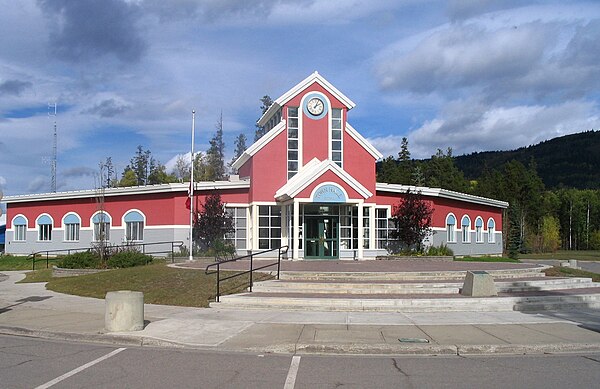20250915
From today's featured article
The red wattlebird is a passerine bird native to southern Australia. With a length of 33–37 cm (13–14½ in), it is the second largest species of Australian honeyeater. It has mainly grey-brown plumage, with red eyes, distinctive pinkish-red wattles on either side of the neck, white streaks on the chest and a large bright yellow patch on the lower belly. Loud and conspicuous, the red wattlebird is generally found in trees, where it gets most of its food; occasionally it forages on the ground. It is one of the largest nectarivorous birds in the world, feeding from a wide variety of flowering plants. Insects also comprise part of its diet. It is territorial and at times aggressive towards birds of other species, often defending rich sources of nectar. Breeding throughout its range, the red wattlebird builds a cup-shaped nest in a tree and raises one or two broods a year. Although it has declined in places from land clearing, it is classified as Least Concern on the IUCN Red List. (Full article...)
Did you know ...
- ... that Sydney McLaughlin's world record of 50.68 seconds in the 400 metres hurdles (medalists pictured) was called "one of the greatest track performances of all time"?
- ... that Emperor Tenmu had his sons swear to honor his consort and niece Uno-no-sarara as their mother, including two of her brothers?
- ... that a 1981 article about the disease of Turku claimed that the city council of Turku was made up of Finnish Freemasons?
- ... that minister George Freeman ran The Monastery as a gay church, nightclub, and homeless shelter in 1980s Seattle?
- ... that Muslim sources say that 50,000 inhabitants "burned alive" in the sacking of Tbilisi in 853?
- ... that No Kaebang's wife, preferring death to capture by Japanese troops, leapt from a cliff while holding her husband's certificate of civil examination?
- ... that "Cwm Rhondda" was written for Capel Rhondda?
- ... that Koh Sok Hiong, a former first lady of Singapore, wrote a cookbook compiling more than 200 of her Perankan recipes?
- ... that the app Baby Shaker was removed from the App Store for letting players shake a baby to death?
In the news
- After widespread protests, Sushila Karki (pictured) is appointed interim Prime Minister of Nepal, replacing K. P. Sharma Oli.
- Former Brazilian president Jair Bolsonaro is sentenced to 27 years in prison for his involvement in a coup plot.
- The observation of a black hole merger verifies the second law of black hole thermodynamics for the first time.
- Political activist Charlie Kirk is shot and killed at an event in Utah, United States.
On this day
September 15: Battle of Britain Day in the United Kingdom (1940)
- 1776 – American Revolutionary War: British forces made an unopposed amphibious landing at Kips Bay on Manhattan, the American defenders having fled due to artillery fire.
- 1795 – French Revolutionary Wars: Great Britain seized the Dutch Cape Colony to use its facilities against the French Navy.
- 1935 – Nazi Germany enacted the Nuremberg Laws (pictured), which deprived Jews of their citizenship.
- 1944 – World War II: American and Australian forces landed on the Japanese-occupied island of Morotai.
- 2017 – A homemade bomb partially exploded on an eastbound District line train at Parsons Green tube station in West London, injuring 30 passengers.
- Catherine of Genoa (d. 1510)
- Edmé Boursault (d. 1701)
- Signe Toly Anderson (b. 1941)
- Prince Harry, Duke of Sussex (b. 1984)
From today's featured list
Papua New Guinea has designated a number of areas as potential UNESCO World Heritage Sites. These sites cover areas of both cultural and natural significance. Only one, the Kuk Early Agricultural Site, has become inscribed as an official site. Archaeology at this site has found evidence of the independent development of agriculture on the island of New Guinea. The other listings remain tentative. Many of these sites were selected following foreign proposals, and while they have national government support, there has been little or no progress towards the protections needed to lodge official nominations since the sites were tentatively listed in 2006. Due to the political power of local communities in the country, any successful nomination would require local support and cooperation. The nomination of this site was made with support from the Kawelka people, who continue to carry out traditional land-use practices at the site. (Full list...)
Today's featured picture
The 2024 Central European floods were a series of floods caused by a record heavy rainfall generated by Storm Boris, an extremely humid Genoa low. The flooding began in Austria and the Czech Republic, then spread to Poland, Romania and Slovakia, and then onwards to Germany and Hungary. The floods caused 28 fatalities and over 4 billion euros in damage. This photograph shows floodwater surrounding the Franciscan monastery in Kłodzko, Poland, on 15 September 2024.
Photograph credit: Jacek Halicki




























